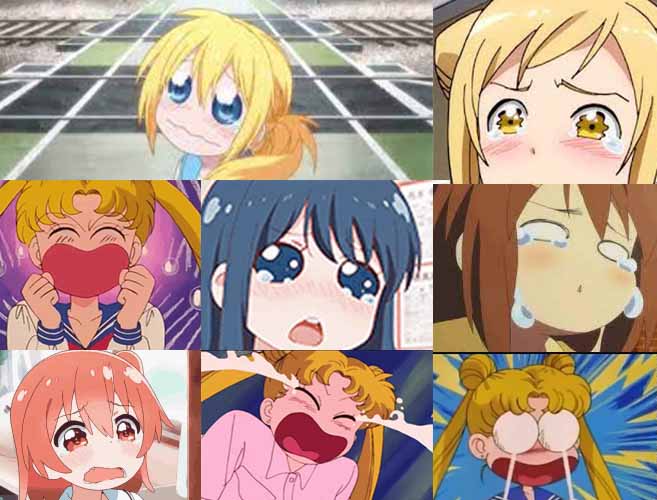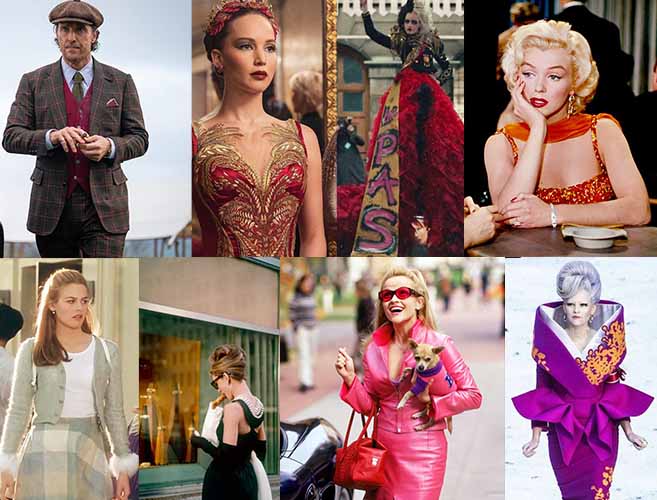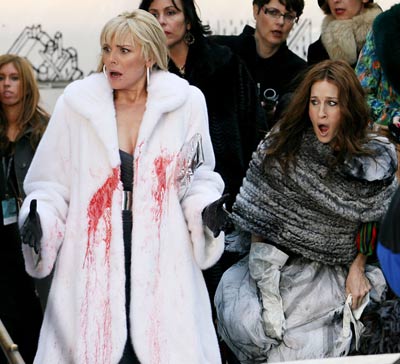Fashion is everywhere in media, be it film or tv, live action or animated, all the way to books in literature and poems, and where there’s Fashion, there’s a Fashion effect.
The classic adage “Show, don’t tell” is often said to be the distinguishing feature between the greats and the not-so-greats, and those that have utilized Fashion in all it’s glorious nuance have come to discover certain “patterns'', recurring motifs and methods that appear to create very specific effects in the aforementioned manner.
These patterns have come to be known as Fashion Media Tropes, and these are their stories...
Like my appetite for floral patterns, the amount of tropes seems to be endless and they are absolutely worth studying further and in-depth, whether you create media or not, but be warned;
once you see and understand a trope, you cannot unsee it, and you might end up feeling less immersed in the latest season of your favourite show because of it, so, you know, just remember, I warned you…
Costume Porn
This is a great one to start with because it lets me use this Scorcese quote;
“I wanted to do a valentine to Hollywood ... This was done through sets, costumes, hair, and makeup. Everything was exaggerated. Shoulder pads were an inch bigger inside, and the ties were made even wider. Giorgio Armani said that he studied the costumes and decided to make clothes, "like New York, New York".- Martin Scorsese, Martin Scorsese: A Journey, Page 102-103, explaining the appeal of the trope and its influence on fashion.
And that quote is great because it touches on what’s great about Fashion in media compared to real life. I’m going to let this collage speak my thousand words for me;

I was never a huge anime fan, but I always admired certain aspects of it from a distance, such as the fact that things in anime look how they actually feel in real life. What do I mean by this?
Well, look at those crying girls; that’s not what crying looks like in real life, but it is what it feels like, all dramatic and snotty and feeling like you’re crying your own bodyweight in tears…
And this is done with everything, from food which looks impossibly delicious to clothing, which is not only impossibly cool or stylish at times, but also perfect/untorn/unblemished at all times, like their hair...
So what exactly is “Costume Porn”?
Have you ever seen a “costume”, like a ball gown for example, that was so elaborate and detailed, so complex yet palatable that it became a character all of its own? Sure you have, you might just not have thought too much about it because you were likely busy experiencing the beauty that is “costume porn”.
The effect on the story varies depending on what the narrative needs and ranges from creating a sense of awe and wonder that mirrors the character’s beauty, all the way to disdain when an unworthy person is seen wearing it, such as a wealthy antagonist…

If you’ve seen the recently-released Cruella movie starring Emma Stone as the fantastically defiant avant-garde Fashionista that wages a battle of styles against the wonderfully decadent and established Baroness of Fashion, played by Emma Thompson, you know exactly what I’m talking about; clothing in that movie is both a weapon and a comfort, an expression and a question, and I’ll be damned if it’s just not plain ol’ fun to look at.
The clothing is both supporting cast and stand-alone experience, and I for one finally understand the appeal of those Fast and Furious movies; replace cars for clothes and you’ve got pretty much the same thing…
I’m not here to tell you that Cruella is some cinematic masterpiece of unrivaled and misunderstood depth; no, it’s a fun movie, but it’s a movie where the clothing is a bold part of the fun, and that’s new and exciting, and hopefully, its wild success will lead to further Fashion-oriented blockbusters. That’s awesome, because great Costume Porn used to almost-exclusively be the domain of books and novels ala Charles Dickens or modern Mary Sue stories.
Wardrobe Flaw of Characterization
As previously pointed out, clothing is perfect in media unless the story needs it not to be, in which case it’s done on purpose and usually to great effect.
Now, this point is not about dressing a character poorly in general, as if you were writing a character that wore literal rags, but rather more of a “chink in the armour” kind of messaging wherein the character’s clothing will be fine except for a small flaw which is usually representative of some aspect of their characterization.
For example, imagine you want to create a character that recently became rich (aka the Nouveau Riche) and is attempting to join high-society but isn’t quite fitting in; how do you tell this background story in a single outfit?
Simple; through the use of a Wardrobe Flaw of Characterization, we can dress the character up in “rich” clothes and have them be ill-fitting or have some small aspect of them be “wrong”,which instantly coveys to the audience that this person is trying but not quite pulling it off, be that due to their newness or the fact that they’re trying too hard or maybe even just a lack of attention to detail.
By altering the thing that’s “wrong” on the outfit, you can completely change the variable parts of this messaging and shape it into exactly what the story needs it to be…
Just to clarify, simply having ill-fitting clothing doesn’t instantly message this point, for the character could be, for example, Fashion-capable and just enjoying the baggy pants trend of The '90s; no, this technique works best when the character is dressing in a manner they're unused to because it emphasizes the awkwardness of their style and in turn, characterization.
Fluffy Fashion Feathers
My god does the media love feathers; for every real life outfit with actual feathers on it, I’ve seen at least 10 portrayals of it in the media. The ratio with reality is out of whack I think for a very simple reason; feathers work better in film/tv than they usually do in real life.
Don’t get me wrong, feathers are absolutely used in “real” clothing, but rarely as much as in media simply because of a practicality of sorts; it just doesn’t feel and look and work as well as it can on the screen and in pictures.
As the trope database says, “Wearing feathers for fashion is almost always to show the wearer is trying to show some measure of style, sophistication, and wealth” while in real life, feathers are usually used to show that you work as a showgirl in a burlesque performance.
This particular trope always reminds me of that Simpson’s scene where a stage-hand explains to Bart that “Cow's don't look like cows on film. You gotta use horses.” as he slaps paint on a horse…

If you haven’t seen it, the point is that it’s a “cinema trick” of sorts, and I find myself often evaluating in-show/movie outfits with feathers for their real-life wearability; spoiler alert, they’re often found lacking… I’ve found that in real life, people like to peacock in slightly less literal ways.
This one in-and-of-itself isn’t a huge behind-the-scenes reveal, but the concept itself harkens back to the very nature of performance and film. Oftentimes, custard is yellow paint, snow is polyester powder and in the days of black and white TV, milk was often used instead of water because it created a more visible rain effect, like in Singing in the Rain.
Because the fake thing looks more authentic than the real, I like to constantly evaluate outfits and look for things that I see often in media Fashion but never in real life. Try it yourself next time you’re watching something, you’ll be surprised how far back you can peel the layers the authors never intended for you to see…
Fake Fabric Fashion Faux Pas
Polyester, in short, is a cultural smirk, a synonym for bad taste.”
— Steve Lohr, "Beyond Leisure Suits: New Life for Polyester", New York Times, March 18, 1991
See, this one is interesting because it works as a time-capsule of sorts. This particular trope was at its peak in the ‘80s as at the time, there was backlash against the garish fashions and polyester-heavy apparel that had been quite common during the '70s. You would commonly have scenes where someone is revealed to be wearing “fake fur” and obviously in turn worthy of scorn and ridicule, especially in ‘richer’ circles but definitely not limited to.
If you needed your character to be a shifty salesman of sorts or an obnoxious boor, you would put him in a cheap polyester-suit, and this effect was recreatable with any article of clothing, from blazers to blouses. Artificial fabrics and the characters that wore them were associated with “fashion-blindness, lack of aesthetic taste, plastic suburban life, and oppressively cheerful mediocrity”.
Now, of course, due to changing fashion attitudes and growing environmental/sustainability concerns, you are more likely to be the target of disdain rather than be dissing it out as wearing real fur is seen as crass, to say the least.

These days, if a character is wearing a polyester-something, it’s usually done ironically and I’m not opening up that can of exponentially-derivative nuance anytime soon...
So, next time you see a flashback scene where the main character is an obvious “fashion victim” in their past or the camera slowly pans over an outfit, pay even more attention to the outfits and you might be surprised by what most people don’t really even notice but are definitely led by, narratively speaking.
Read more about how Fashion affects you here.
